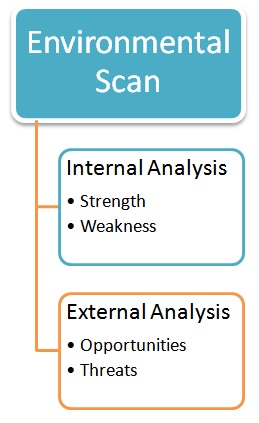A scan of the internal and external environment is an important part of the strategic planning process. Environmental factors internal to the firm usually can be classified as strengths (S) or weaknesses (W), and those external to the firm can be classified as opportunities (O) or threats (T). Such an analysis of the strategic environment is referred to as a SWOT analysis.
The point of a SWOT analysis is to help you develop a strong business strategy by making sure you’ve considered all of your business’s strengths and weaknesses, as well as the opportunities and threats it faces in the marketplace.
Strengths and weaknesses are internal to the company (think: reputation, patents, location). You can change them over time but not without some work. Opportunities and threats are external (think: suppliers, competitors, prices)—they are out there in the market, happening whether you like it or not. You can’t change them.
Strengths
A firm’s strengths are its resources and capabilities that can be used as a basis for developing a competitive advantage. Examples of such strengths include:
- patents
- strong brand names
- good reputation among customers
- cost advantages from proprietary know-how
- exclusive access to high grade natural resources
- favorable access to distribution networks
Questions ask(s):
- What do you do well?
- What internal resources do you have? Think about the following:
- Positive attributes of people, such as knowledge, background, education, credentials, network, reputation, or skills.
- Tangible assets of the company, such as capital, credit, existing customers or distribution channels, patents, or technology.
- What advantages do you have over your competition?
- Do you have strong research and development capabilities? Manufacturing facilities?
- What other positive aspects, internal to your business, add value or offer you a competitive advantage?
Weaknesses
The absence of certain strengths may be viewed as a weakness. For example, each of the following may be considered weaknesses:
- lack of patent protection
- a weak brand name
- poor reputation among customers
- high cost structure
- lack of access to the best natural resources
- lack of access to key distribution channels.
In some cases, a weakness may be the flip side of a strength. Take the case in which a firm has a large amount of manufacturing capacity. While this capacity may be considered a strength that competitors do not share, it also may be a considered a weakness if the large investment in manufacturing capacity prevents the firm from reacting quickly to changes in the strategic environment.
Question(s) ask here:
- What factors that are within your control detract from your ability to obtain or maintain a competitive edge?
- What areas need improvement to accomplish your objectives or compete with your strongest competitor?
- What does your business lack (for example, expertise or access to skills or technology)?
- Does your business have limited resources?
- Is your business in a poor location?
Opportunities
The external environmental analysis may reveal certain new opportunities for profit and growth. Some examples of such opportunities include:
- an unfulfilled customer need
- arrival of new technologies
- loosening of regulations
- removal of international trade barriers
Questions ask here:
- What opportunities exist in your market or the environment that you can benefit from?
- Is the perception of your business positive?
- Has there been recent market growth or have there been other changes in the market the create an opportunity?
- Is the opportunity ongoing, or is there just a window for it? In other words, how critical is your timing?
Threats
Changes in the external environmental also may present threats to the firm. Some examples of such threats include:
- shifts in consumer tastes away from the firm’s products
- emergence of substitute products
- new regulations
- increased trade barriers
Questions ask here:
- Who are your existing or potential competitors?
- What factors beyond your control could place your business at risk?
- Are there challenges created by an unfavorable trend or development that may lead to deteriorating revenues or profits?
- What situations might threaten your marketing efforts?
- Has there been a significant change in supplier prices or the availability of raw materials?
- What about shifts in consumer behavior, the economy, or government regulations that could reduce your sales?
- Has a new product or technology been introduced that makes your products, equipment, or services obsolete?
Existing businesses can use a SWOT analysis, at any time, to assess a changing environment and respond proactively. In fact, I recommend conducting a strategy review meeting at least once a year that begins with a SWOT analysis.
New businesses should use a SWOT analysis as a part of their planning process. There is no “one size fits all” plan for your business, and thinking about your new business in terms of its unique “SWOTs” will put you on the right track right away, and save you from a lot of headaches later on.
References:
Tim Berry (Bplans(dot)com)
Articles


















